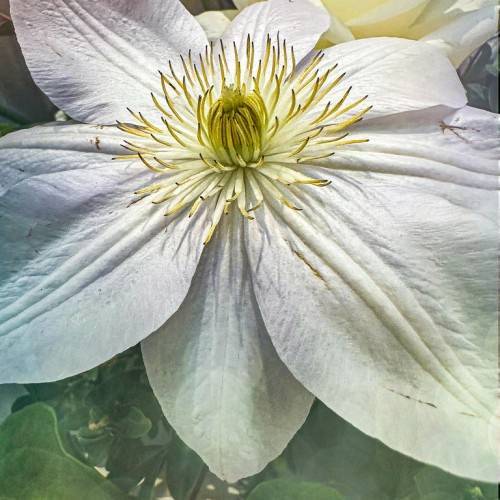
clematis
Clematis 'Silver Moon'
Cycle:
Perennial
Watering:
Average
Hardiness Zone:
4 - 9
Flowers:
Flowers
Sun:
Full sun,part shade
Leaf:
Yes
Growth Rate:
High
Maintenance:
Low
Salt Tolerant:
Yes
Care Level:
Medium
watering
Clematis 'Silver Moon' should be watered thoroughly once a week, providing a minimum of 1 inch of water each time. Water should be applied to the soil around the plant rather than directly on the foliage. During the summer months, it is beneficial to water the plant more frequently, up to twice a week with 1 inch of water at each watering. If the plant is growing in a pot, it should be watered more frequently than if planted in the ground. It is important to water deeply rather than lightly to encourage deep root growth.
sunlight
Clematis 'Silver Moon' is a fast-growing, deciduous perennial that thrives in full sun, although it can also tolerate partial shade. It should receive at least 6 to 8 hours of direct sunlight each day in order to stay healthy and produce the best blooms. When grown in full sun, Clematis 'Silver Moon' will produce the most abundant and colorful blooms. If it is grown in partial shade, it will still produce blooms, but they may not be as vibrant or plentiful.
pruning
Clematis 'Silver Moon' should be pruned in late winter, typically between late February and March. This plant should be pruned back to about 18 inches, so that the new shoots will grow more vigorously. Doing so will also help to promote healthier flower production. After the initial pruning in the late winter months, any dead or diseased material should be removed periodically in the summer. You can also prune clematis in mid-summer to clean up growth or remove off-shoots if needed.
FAQ
Can Clematis plants grow in pots?
Yes, Clematis plants can definitely be grown in pots. When planting a Clematis in a pot make sure to use a larger size pot with drainage holes and fill it with a mix of well-draining potting soil and compost. Ensure to keep the root area cool and the pot in a sunny location while providing regular water and fertilization. Check the plant almost daily to make sure it is not becoming too dry. Clematis can do well in a pot and with the right care and conditions, they will thrive.
Are Clematis plants self-pollinating?
No, clematis plants are not self-pollinating. Clematis plants need pollinators such as bees, butterflies, moths and other insects to transfer pollen from the male anthers to the female stigma of the flower in order to produce viable seed. Pollination must also occur within relatively close proximity of the same species in order to create viable hybrid plants.
Can Clematis plants be grown as a houseplant?
Yes, Clematis plants can be grown as a houseplant. It is best to grow them in a pot with full sun and a soil that is rich in organic material and retains moisture. When potting the plant, place a stake or trellis next to the pot so that the vine can climb when it begins to grow. Be sure to water your Clematis plant regularly to keep it healthy and growing. Additionally, keep an eye out for pests and treat with natural insecticides as necessary.
Could Clematis plants survive in a colder climate?
Yes, Clematis plants can survive in colder climates with proper preparation. If planted in the fall, proper mulching should be done to protect the roots from cold temperatures. If planted in the spring, they should be watered frequently to help them adjust to the cooler temperatures more quickly. If temperatures drop below -20°C ( -4°F), additional measures may need to be taken such as the application of protective wraps and thermal insulation. Additionally, plants in exposed areas should be protected from the wind to prevent excessive dehydration. With the right measures in place, Clematis plants can easily survive in colder climates.
Could Clematis plants be grown in a greenhouse?
Yes, clematis plants can be grown in a greenhouse. Due to their vine-like growth habit and tropical native origins, clematis plants thrive in the moist and warm environment of a greenhouse. Clematis are generally grown from cuttings or from dividing existing plants, and benefit from regular pruning and fertilizing. They will also enjoy the indirect light of a greenhouse and the protection from strong winds and temperatures that the humidity and contained environment provides.
